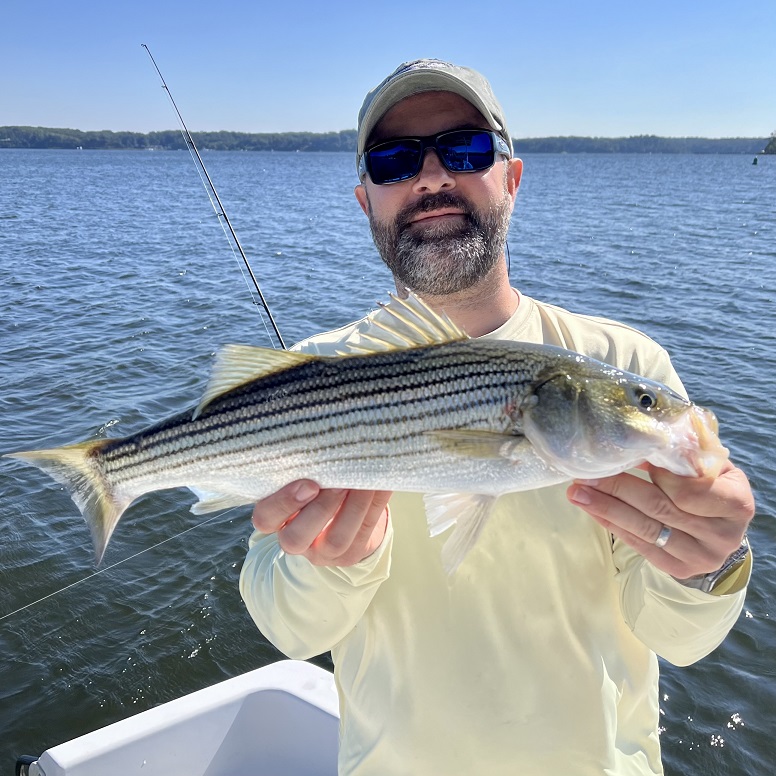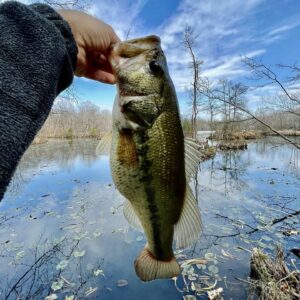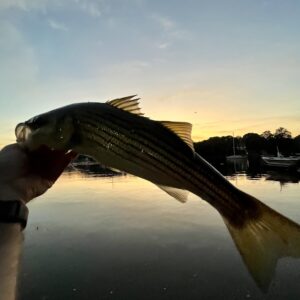Welcome to Reel Chesapeake’s Weekly Fishing Report, our interpretation of what’s biting and where throughout the Chesapeake Bay watershed. Please email us directly at editor@reelchesapeake.com to share updates and photographs of your recent catches for potential inclusion in next week’s column. The leading photograph (above): Schoolie caught from a mini blitz in the Severn River on Tuesday morning, 9/19, with a 3/4oz silver/chartruese Rat-L-Trap.
The middle Chesapeake Bay region has experienced a wonderful week of weather—cool nights dipping to high-50F temps, a couple brilliant sunny days, a few with cloud cover, and winds teetering on the edge of comfortable/safe for small/mid-size craft. A waxing moon approaching the first-quarter on 9/22 has meant darker nights (so possibly/slightly less overnight feeding activity) and created long-lasting/mild tides. The winds have dominated current-creation, especially in the narrower rivers.
These variables have set up a couple high-potential fishing days, Thursday and Friday, before the wet ‘n wild weekend forecast. NOAA has a system classified as a “disturbance” in the southeastern Atlantic moving northward and, by Saturday, potentially bringing tropical rains and gale-force winds to the region. Getting on the water will likely not be advisable for any craft. Hopefully, the system blows through and the region continues the autumn cool down (the Autumn Equinox is also Saturday!).
The surface water temperatures have cooled in the past week—down from about 80F to 77 in the Severn River. Bay anglers are reporting temps hovering around 75. Baitfish—a mix of peanut bunker and anchovies mostly—are actively cruising the creeks and starting to migrate down the rivers. They’ll keep moving through the main stem of most rivers, eventually toward the mouths, and out to the main Bay in the month-plus ahead. The temp swing has activated this activity and has striped bass on the feed. Schools are busting baitballs in open water, but have been very quick to surface before diving down. If you can find lots of sitting birds, hang within casting distance of them and either follow the flock when it starts chasing fish to the blitz or hang tight and wait for the blitz to make its way back to you. A slightly heavier lure up to 3/4oz, like a lipless crank, Kastmaster, or plastics on lead, gives you casting distance and can hit deeper when the fish dive. I found the fish feeding throughout Round Bay in the Severn past the 10 o’clock hour and picked up a few on silver/chartreuse Rat-L-Traps—proof the morning bite continues to lengthen well beyond sunrise.
Most of the fish caught at the river mouths and in the Bay proper have been in the mid-20” range. A few anglers claimed fish up to 30, and I think the bigger fish may still be in the Patapsco vicinity. As bait migrates, so too should the larger resident stripers to the Bay Bridge, Eastern Bay, and further down to Poplar Island. Quality fish are being taken at popular locations on a variety of topwater plugs and jerkbaits. Shallow water near structure in the morning and evening will hold nice fish. Work quietly along the shorelines and you’re bound to hook into a few. I’m aiming to fish over oyster beds in slightly deeper water and will report on that bite.
Another slot red drum was caught this week, even further up the Severn River, by angler Robbie Lahart and guests. This drum measured about 25” and if these pup catches are another indication of an improving fishery, we’ll take it. For the record, the Severn River Association has reported pretty healthy oxygen levels throughout the river this week, save for the bottom third of the water column in parts of Round Bay. And salinity levels have been above 10 parts, which is also good news, especially for the oyster reefs.
While the focus of many Bay anglers has shifted almost exclusively to stripers, some bluefish and Spanish mackerel are still being caught further south near the lower 80 buoys and below. But these schools are thinning out and moving down the Bay. Bull reds and cobia (catch and release only, since keeper season officially ended 9/15) are still the big targets of the charter fleets working the water from Point Lookout across to Tangier Sound and south to the Chesapeake Bay Bridge Tunnel. Sight casting large leadheads with bright, 7” paddletails has been effective.

With the cool down, we should start seeing white perch move out of their upriver haunts and toward deeper water (those oyster beds). For now, you still have a shot at catching a stringer’s worth by fishing deepwater docks, laydowns, and other structures, especially in pockets of shade. My favorite lure this season has been a 2” micropaddletail on an 1/8oz jighead. Avoid slack tides if possible.
In fresher water, there’s excellent largemouth bass, northern snakehead, and smallie fishing. Headwaters, coves, creeks, and ponds with vegetation hold the fish. The most consistent tribs include the Baltimore rivers, western Patapsco, upper Patuxent, D.C.-region creeks off the Potomac, upper Choptank, and the entire Blackwater system on the Eastern Shore. Try bright flukes, paddletails, or grubs rigged weedless. Topwater frogs in the early or late hours are also effective. Experiment, have fun. Smallies are holding in the Monocacy near Frederick, NoVa portion of the Potomac (and westward), and as far east as the Little Patuxent in Savage. Bonus: bring an ultralight or 3–5wt fly setup and fish for bluegills and other sunfish with dry/dropper rigs, tiny buggers, San Juan worms, or teeny tiny inline spinners. What a hoot. Good luck!
This report appears within On The Water magazine’s weekly collection of Chesapeake Bay fishing reports.





